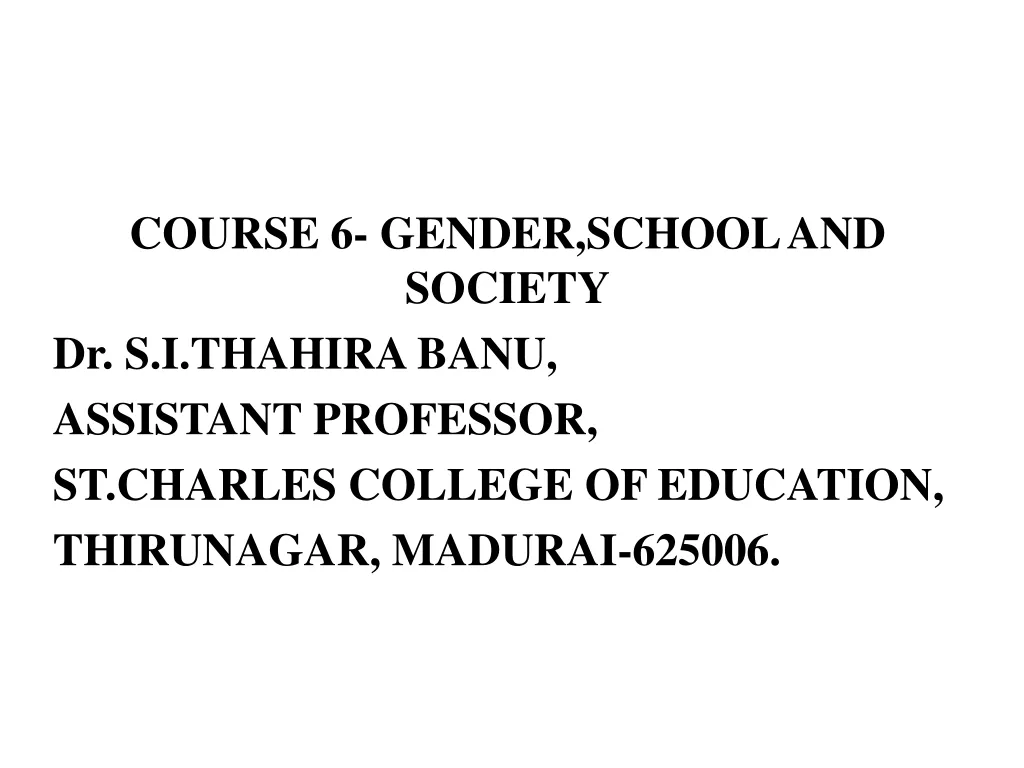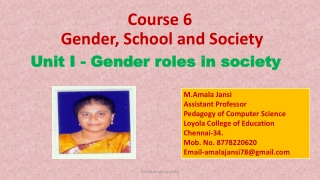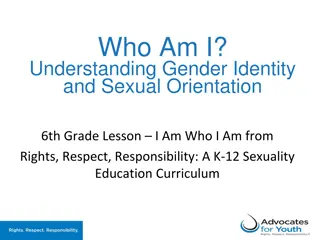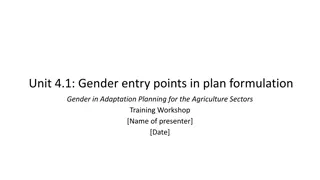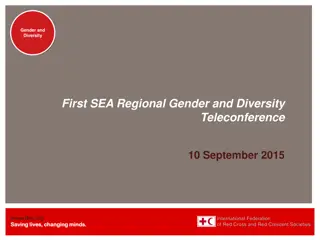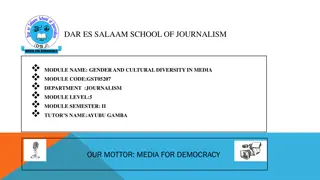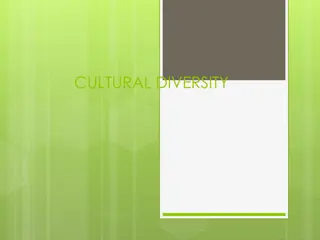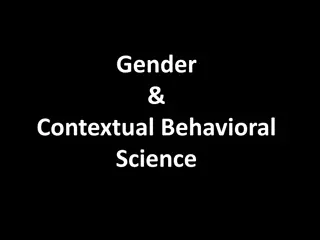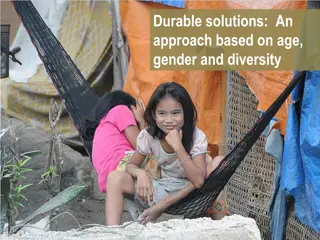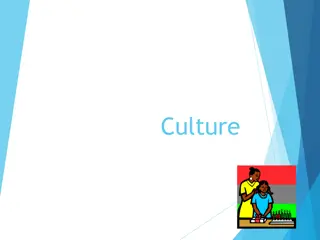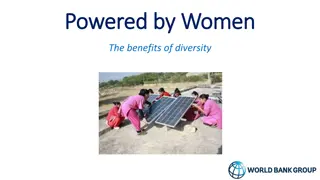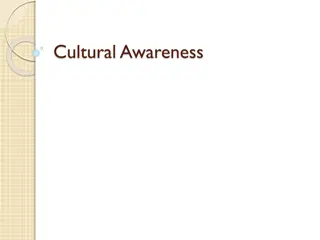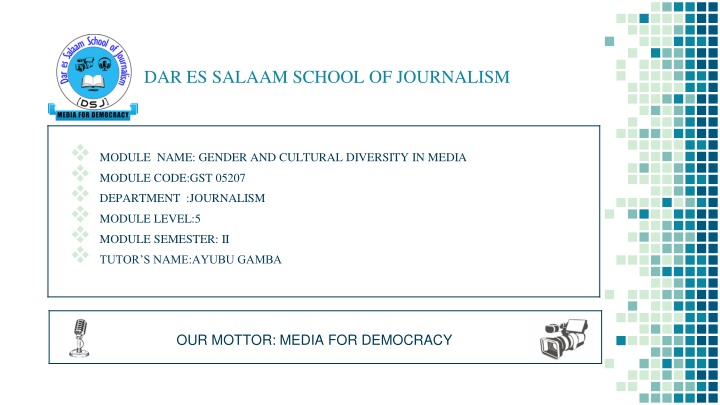
Gender and Cultural Diversity in Media: Understanding Gender Construction
Explore the dynamics of gender construction and cultural diversity in media through topics like gender mainstreaming, organizational protocols, and gender analysis. Understand the concepts of gender, gender equality, and gender integration in journalism practices.
Download Presentation

Please find below an Image/Link to download the presentation.
The content on the website is provided AS IS for your information and personal use only. It may not be sold, licensed, or shared on other websites without obtaining consent from the author. If you encounter any issues during the download, it is possible that the publisher has removed the file from their server.
You are allowed to download the files provided on this website for personal or commercial use, subject to the condition that they are used lawfully. All files are the property of their respective owners.
The content on the website is provided AS IS for your information and personal use only. It may not be sold, licensed, or shared on other websites without obtaining consent from the author.
E N D
Presentation Transcript
DAR ES SALAAM SCHOOL OF JOURNALISM MODULE NAME: GENDER AND CULTURAL DIVERSITY IN MEDIA MODULE CODE:GST 05207 DEPARTMENT :JOURNALISM MODULE LEVEL:5 MODULE SEMESTER: II TUTOR S NAME:AYUBU GAMBA OUR MOTTOR: MEDIA FOR DEMOCRACY
TOPIC 4 TOPIC 1 Assess gender mainstreaming efforts in news reporting and media management. The processes of social construction of gender in the society. TOPIC 5 TOPIC 2 Demonstrate organizational protocols in different context. The concepts of cultural diversity in relation to journalism practices. TOPIC 3 Demonstrate knowlegde of gender issues in society.
TOPIC 1:Processes of Gender construction What is gender? refers to the economic, social, political, and cultural attributes and opportunities associated with being women and men. The social definitions of what it means to be a woman or a man vary among cultures and change over time. Gender is a sociocultural expression of particular characteristics and roles that are associated with certain groups of people with reference to their sex and sexuality. Gender is used as a means of describing the distinction between the biological sex and socialized aspects of femininity and masculinity. According to West and Zimmerman, is not a personal trait; it is "an emergent feature of social situations: both as an outcome of and a rationale for various social arrangements, and as a means of legitimating one of the most fundamental divisions of society. or 3
Continued Gender is the state of being male or female (typically used with reference to social and cultural differences rather than biological ones).
Categories of Gender Gender Analysis is a methodology that both: Describes existing gender relations in a particular environment, ranging from within households or firms to a larger scale of community, ethnic group, or nation. It involves collecting and analyzing sex-disaggregated data and other qualitative and quantitative information. Organizes and interprets, in a systematic way, information about gender relations to make clear the importance of gender differences for achieving development objectives. Gender Assessment examines how a program or project addresses and responds to gender disparities and inequalities through its objectives, activities, and policies. Gender Equity is the process of being fair to women and men. To ensure fairness, measures must be taken to compensate for historical and social disadvantages that prevent women and men from operating on a level playing field.
Continued Gender Equality is the state or condition that affords women and men equal enjoyment of human rights, socially valued goods, opportunities, and resources. Gender Integration refers to strategies applied in program assessment, design, implementation, and evaluation to take gender norms into account and to compensate for gender-based inequalities. Gender Mainstreaming is the process of incorporating a gender perspective into policies, strategies, programs, project activities, and administrative functions, as well as into the institutional culture of an organization. Gender Stereotypes are ideas that people have on masculinity and femininity: what men and women of all generations should be like and are capable of doing. (e.g., girls should be obedient and cute, are allowed to cry, and boys are expected to be brave and not cry, women are better housekeepers and men are better with machines, or boys are better at mathematics and girls more suited to nursing). Gender-Based Violence is violence derived from gender norms and roles as well as from unequal power relations between women and men. Violence is specifically targeted against a person because of his or her gender, and it affects women disproportionately. It includes, but is not limited to, physical, sexual, and psychological harm (including intimidation, suffering, coercion, and/or deprivation of liberty within the family or within the general community). It includes violence perpetuated by the state.
HOW TO CONSTRUCT GENDER IN THE SOCIETY Did you ever wonder who made up the notion of blue for boys and pink for girls? Where did the ideas that boys don't cry or girls should play with dolls come from? Such gender socialization is done before a child is even born. We have all played victim to this. Who hasn't bought a gendered baby gift or attended a pink princess's one year-old birthday party? Understanding gender isn't as easy as one may think. Gender is on a variety. Being able to define one s own identity and to have society respect it is the prime reason why the gender binary is a principle that we must do away with. One should have the sole right to make their own decisions including the right to use which ever bathroom one feels most comfortable using. However we aren t permitted to live in a world that is free from patriarchal and binary gender systems. Society distorts facts and wants people to prove their manhood or their womanhood. What is a display of womanhood? What is a display of manhood? Is it only physical? Do breasts prove that someone is a woman? Does being able to produce working sperm mean that you are a real man? What about the mother of two who had to have a double mastectomy after finding out she had breast cancer? Does she not qualify as a woman anymore because she lost her breast? These questions and more are dilemmas caused by a false binary.
Institution for social construction of gender in society Family Education institutions Religion Working place Media institutions IMPORTANCE OF SOCIAL CONSTRUCTION OF GENDER IN SOCIETY Identification of gender It help male and female to work in gender roles Help for the socialization within the society Help to avoid misunderstanding among male and female for their responsibility
Full name: Ayubu Gamba Department: Journalism Email Address: agamba133@gmail.com Phone number: 0718042903 CONTACT TUTOR IN CHARGE

